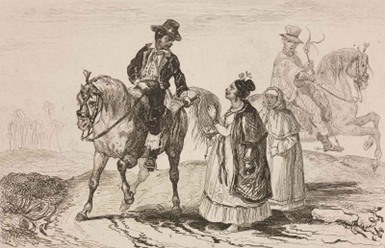Written by Rochelle Guida
In the above photo: López Palace in Asunción, Paraguay
CASLT’s Discovering Languages series aims to spark interest in plurilingualism and pluriculturalism among language learners, school communities, and the public. Each featured language is explored in a blog article and accompanied by a classroom-ready activity for language teachers. Use these activities to promote and popularize language learning among your students and help them develop intercultural competencies.
The Guaraní language is an Indigenous language of South America with a rich and fascinating history. Rooted in Latin, it is spoken by millions of people in Brazil, Bolivia, Argentina, and by over 80% of Paraguayans. Interestingly, it is “the only Indigenous language in the Americas spoken by a majority of the non-Indigenous population.”
One of the most notable aspects of the Guaraní language is its resilience in the face of colonialism. In her article “Can This Indigenous Language Thrive in a Digital Age?,” Frances Jenner unpacks several historical reasons for Guaraní’s continued presence in today’s society:
Unlike hundreds of Indigenous languages that have been wiped out in South America since the period of European colonialism began in the 1500s, Guaraní has survived […] During the War of the Triple Alliance in the late 19th century, which saw Argentina, the Empire of Brazil, and Uruguay in league against Paraguay, generals of the Paraguayan army sent messages to one another in Guaraní so their enemies would be none the wiser if they were intercepted.
Jenner also observed that the language is strategically used today by soccer players as “a tactic to baffle their opponents.”

Source: De Agostini/Getty Images.
An Oral and Cultural Tradition
As a language, Guaraní has been passed down orally. It is closely tied to cultural traditions and beliefs so it is an important part of daily life. The Guaraní language is structurally simple yet easily comprehensible. For example, words do not end in consonants. One visitor to Paraguay noticed that the simplicity of the linguistic structure of Guaraní directly supports the cultural norms of Guaraní people who do not require “extravagant words” to communicate.
Guaraní also has strong roots in the Spanish language, with many of its speakers actively code-switching between the two languages, using both languages simultaneously to create a message. Langfocus, which provides a 16-minute video about Guaraní, provides this example of a sentence with some cross-over to the Spanish language:

Guaraní’s Lessons for Language Learning
The Guaraní language has been defined as “remarkably resilient.” Exploring the linguistic features of Guaraní reminds us to recognize the value of keeping vocabulary simple and meaningful for language students. Furthermore, Guaraní’s ability to coexist with Spanish suggests that language teachers should not be afraid to allow other dominant languages, such as English or French, into their teaching contexts. In fact, code-switching can help students make connections. If we think of two languages as a person’s two parents, then code-switching is like mixing two sets of linguistic genes. Each language (parent) has a different background and experiences yet both contribute to the same desired message.
Just as it is common to see, hear, and taste the Guaraní language — such as the word yuyos for “traditional medicinal herbs that they assure will cure any ailment, from hangovers to high cholesterol” — written language is only one important element for language students. More memorable language learning content helps maintain a language’s presence in society. Placing greater emphasis on oral language development in our classrooms is the key. Continuing to offer a variety of language activities where students shift from merely presenting to interacting in the target language provides the needed catalyst.
Making Connections and Preserving Language With Code-Switching
Summary of the Activity
90–110 minutes
This activity is best suited for a high school FSL or ESL classroom of intermediate or advanced language learners (e.g., B1 as per the DELF).
The purpose of the activity is to celebrate linguistic and cultural diversity, explore the unique language of Guaraní, and make connections to French, English, and/or another target language in the student repertoire. The teacher will introduce students to code-switching and its benefits for language learning. While working through the activity, students may demonstrate concepts of translanguaging.
Required materials:
- Internet
- Computer speakers
- Pen and paper and/or student access to electronic devices for note-taking and note-sharing
Introducing the Activity
Before beginning the main activity, the teacher can discuss the following questions with students:
- What does it mean to be resilient, specifically as a language speaker?
- What gives a language power to maintain its presence?
- Why is it important to make connections between languages?
- What do “first language,” “native language,” and “mother tongue” mean?
- What does “target language” mean?
Ideally, these questions should be posed in the target language but can also be left in the mother tongue of the classroom. Students could answer these questions following a think-pair-share model where they first take the time to privately consider their answer (think), then share their thoughts with an elbow partner (pair), and then discuss their responses with the whole-group (share). The teacher should also have their own responses to share with the class. Guiding photos of resiliency, such as the photo below, can be mounted throughout the introduction of the activity to assist reflection.

This introduction should take about 15–20 minutes to complete.
Activity Sequence
Introduce the Guaraní language to students using the summarized language presentation from Langfocus. This 16-minute video (in English) focuses on the history of Paraguay, the origins of Guaraní, and the features of the language (nouns, verbs, etc.). Students who understand English can take notes and/or the teacher can summarize the main ideas in the target language if needed.
Students can answer the following questions to confirm comprehension and to enhance learning. These questions could be left in English or translated into another language. Most of the questions can be answered by watching the first five minutes of the video.
- Who speaks Guaraní?
- Why is the Guaraní language considered “resilient” according to Langfocus?
- What is the most popular Guaraní variety? How many speakers use this language?
- True or false: Guaraní was originally a written and an oral language.
- How did the Guaraní language survive after Spanish invaders arrived in Paraguay? Please consider the geographical location of Asunción in your response.
- How did Jesuit missionaries help to preserve the Guaraní language?
- What were the benefits of speaking Guaraní for Paraguayan politicians?
- When was Guaraní established as a national language?
- When was Guaraní established as an official language?
- According to a 2012 census, how many Paraguayans speak Guaraní?
- What does “Jopara” mean?
- Guaraní spelling (orthography) is rooted in __________.
- True or false: Guaraní words always end with a consonant.
- How many pairs of vowels does Guaraní have?
- What are some interesting words in Guaraní? What do they mean?
- What are some interesting language features (e.g., verbs, noun forms, etc.)?
- Who tends to speak more Guaraní than Spanish when code-switching (Jopara)? Why do you think this is the case?
- What is an example of Jopara? (See 14:10 of the Langfocus video).
Watching the video and then completing/discussing the questions should take approximately 30–45 minutes.
Consolidating Learning
After reviewing the linguistic features of Guaraní, students can apply Jopara, or code-switching, into other languages. It would be beneficial to begin by using the classroom language and the students’ mother tongue(s) for this exercise. While the students create their sentences, the teacher could encourage them to think in their own languages and follow the principles of translanguaging.
Referring to examples from the Guaraní video, students can work in small groups (or individually) to create 5–10 sentences that combine at least two languages. To help students construct their sentences, the teacher can ask students to think about popular words used in their native language in everyday actions or situations. For example, using English and French, J’adore manger des cakes (I like eating cakes).
The teacher can also use this screenshot from the Guaraní video as an example to display while students complete the activity:

Based on student progress, the teacher could ask students to create a dialogue from their sentences and present it in a subsequent class. Or the sentences can simply be recorded on chart paper, the chalkboard, an online shared classroom document, etc. This should take about 30 minutes to complete (or can be extended at the teacher’s discretion).
Prior to concluding the activity, students can discuss their experiences in a whole-group setting (approximately 15 minutes):
- What was challenging when completing the task and why?
- Should we code-switch whenever we use our target language? Why or why not?
- Do we notice any popular words from our first language used in the target language of the classroom? Why do you think they are popular?
- Why is code-switching beneficial for second-language learning?
Adapting the Activity to Other Contexts
The overall format and content of this activity can be easily adapted into other contexts (e.g., elementary, postsecondary). For example, at the postsecondary level, students could explore the effects of colonization on Paraguay at a more profound level and compare their findings with the target language of their course.




